Assessing the value of rare cards requires a multifaceted approach, taking into account market demand, condition grading, rarity classification, historical sales data, and expert appraisals. By understanding these factors, collectors and investors can navigate the complexities of the rare card market more effectively. Additionally, utilizing platforms like eBay, TCGPlayer, and Heritage Auctions can enhance the buying and selling experience, catering to diverse collector needs.
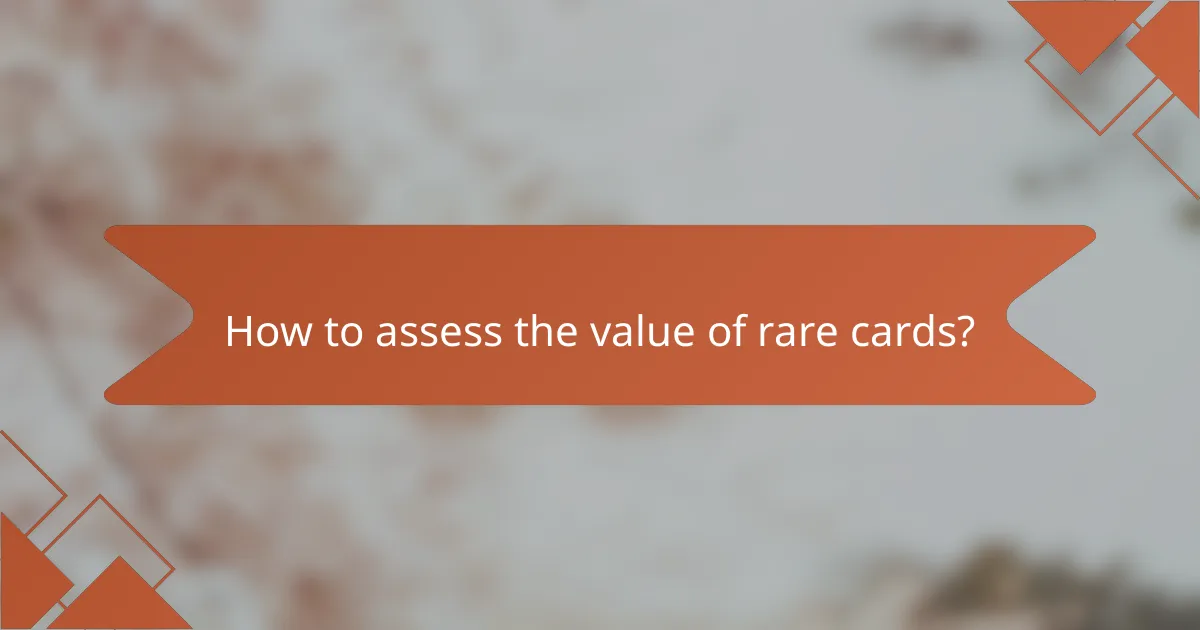
How to assess the value of rare cards?
Assessing the value of rare cards involves analyzing market demand, grading their condition, classifying their rarity, reviewing historical sales data, and considering expert appraisals. Each of these factors contributes to a comprehensive understanding of a card’s worth in the marketplace.
Market demand analysis
Market demand analysis focuses on how much collectors are willing to pay for rare cards. This can fluctuate based on trends, popularity of the card game, and the specific card’s appeal. Monitoring online marketplaces and auction sites can provide insights into current demand levels.
To gauge demand, consider checking platforms like eBay or specialized trading card sites. Look for completed sales to see what similar cards have sold for recently, which can indicate how much buyers are currently valuing those cards.
Condition grading
Condition grading is crucial in determining a card’s value, as even slight imperfections can significantly affect price. Cards are typically graded on a scale from 1 to 10, with 10 being gem mint condition. Common grading standards include PSA and BGS, which provide detailed criteria for assessing card quality.
When evaluating condition, inspect for wear, surface scratches, and centering. A card in near-mint condition can be worth several times more than one with noticeable flaws, so accurate grading is essential for a fair valuation.
Rarity classification
Rarity classification categorizes cards based on how many were produced, influencing their desirability and value. Cards can be categorized as common, uncommon, rare, or ultra-rare, with ultra-rare cards typically commanding the highest prices due to their limited availability.
Understanding the rarity of a card can help collectors prioritize their purchases. For instance, a card from a limited print run or a special edition release is likely to be more valuable than a card that is widely available.
Historical sales data
Historical sales data provides a benchmark for assessing a card’s current value. By reviewing past sales, collectors can identify trends and price fluctuations over time. This data can often be found in price guides or databases that track card sales.
Look for patterns in the sales of similar cards to estimate a fair market price. For example, if a particular card has consistently sold for between $100 and $200 over the past year, it’s reasonable to expect a similar price range for future sales.
Expert appraisals
Expert appraisals involve consulting professionals who specialize in rare cards to obtain an informed valuation. These experts can provide insights based on their experience and knowledge of the market, often considering factors that may not be immediately apparent to collectors.
When seeking an appraisal, choose reputable appraisers or grading services. Their assessments can help confirm your card’s value and provide documentation that may be beneficial for resale or insurance purposes.
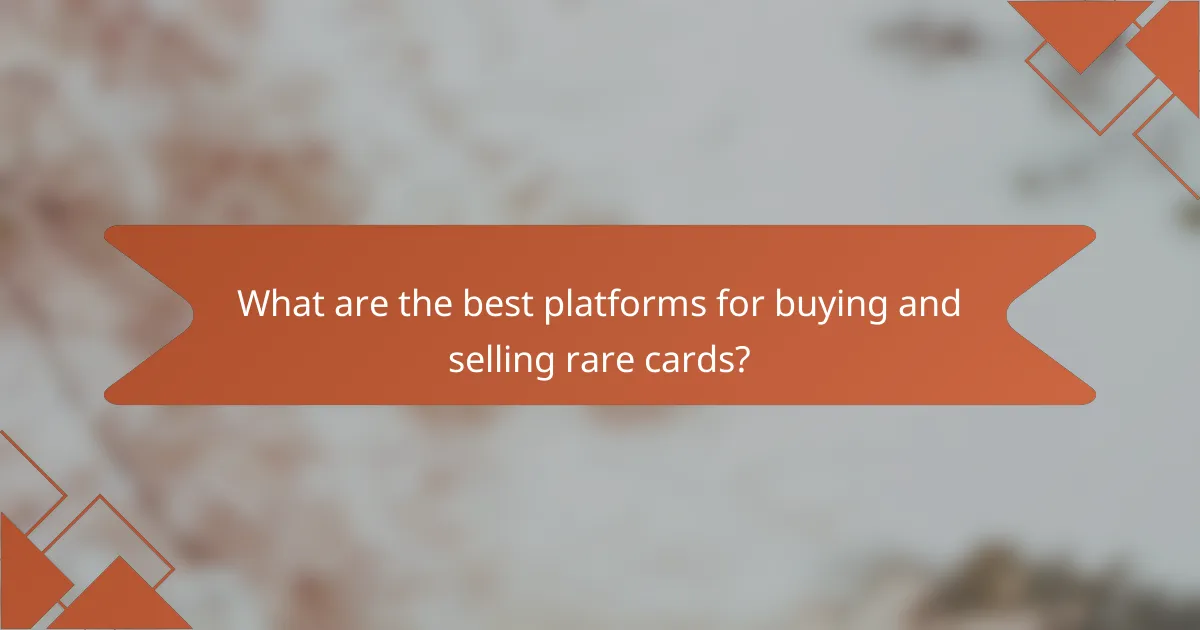
What are the best platforms for buying and selling rare cards?
The best platforms for buying and selling rare cards include eBay, TCGPlayer, Heritage Auctions, and Beckett Marketplace. Each platform has unique features and user bases that cater to different types of collectors and investors.
eBay
eBay is one of the largest online marketplaces for rare cards, offering a vast selection from individual sellers and retailers. Users can bid on items or buy them outright, with prices often reflecting current market trends.
When using eBay, consider the seller’s ratings and reviews to ensure a trustworthy transaction. Be aware of shipping costs and potential buyer protection policies, which can vary by seller.
TCGPlayer
TCGPlayer specializes in trading card games and collectibles, making it a go-to platform for enthusiasts. It features a user-friendly interface and provides price guides based on real-time sales data.
Buyers can purchase cards directly or through a marketplace of sellers, allowing for competitive pricing. Sellers benefit from a streamlined process to list their cards and reach a targeted audience.
Heritage Auctions
Heritage Auctions is known for high-value auctions and rare collectibles, including cards. This platform is ideal for sellers looking to auction high-end items to a global audience.
Keep in mind that Heritage Auctions charges seller’s fees, which can affect your final profit. Bidding typically starts low, but rare cards can fetch significant prices, especially if they are graded highly.
Beckett Marketplace
Beckett Marketplace focuses on graded cards and offers a platform for both buying and selling. It is well-regarded for its grading services, which can enhance a card’s value and appeal.
When using Beckett, check the grading standards and ensure that the cards meet your expectations. The marketplace also provides tools for tracking card values and trends, helping you make informed decisions.
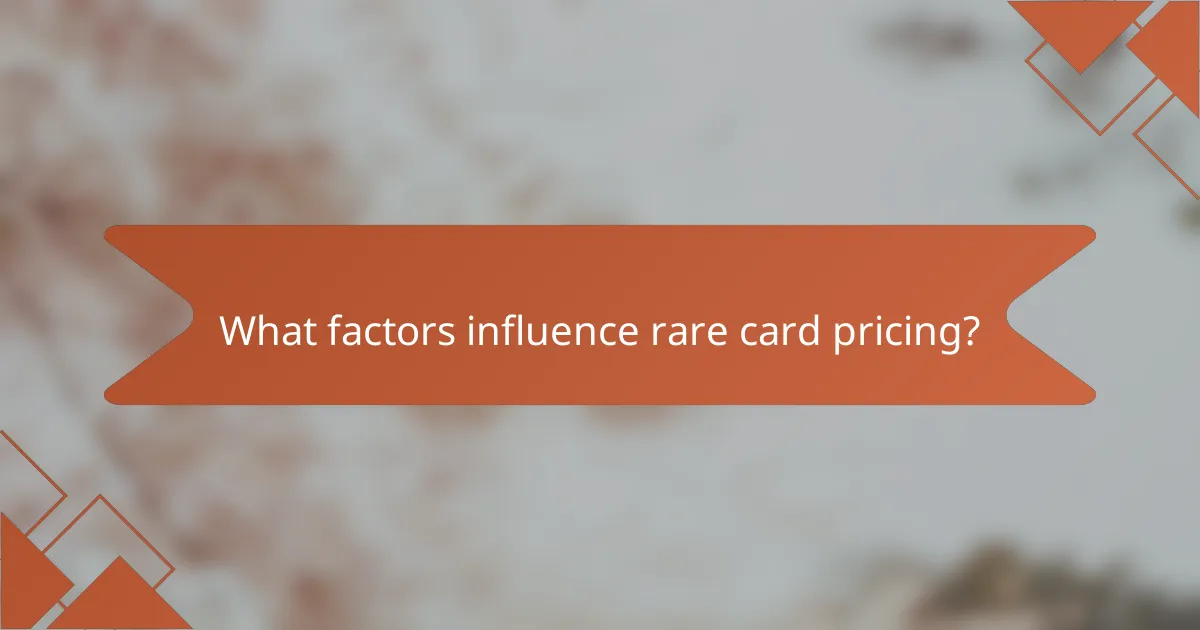
What factors influence rare card pricing?
Several key factors influence the pricing of rare cards, including their condition, market trends, collector interest, and the reputation of grading companies. Understanding these elements can help buyers and sellers make informed decisions in the rare card market.
Card condition
The condition of a rare card is one of the most critical factors affecting its value. Cards are typically graded on a scale from poor to mint, with higher grades commanding significantly higher prices. For instance, a card in near-mint condition can be worth several times more than the same card in good condition.
When assessing card condition, look for wear, scratches, and centering issues. Using a magnifying glass can help identify subtle flaws that may impact grading. Always handle cards carefully to maintain their condition and value.
Market trends
Market trends play a significant role in determining the price of rare cards. Prices can fluctuate based on demand, popularity of specific sets, or even external factors like economic conditions. For example, a surge in interest for a particular player or set can lead to rapid price increases.
Staying informed about market trends involves following auctions, sales data, and collector forums. Regularly checking platforms like eBay or specialized marketplaces can provide insights into current pricing and demand levels.
Collector interest
The level of collector interest can greatly influence a card’s price. Cards that have a dedicated fan base or are tied to popular players often see higher valuations. Limited editions or cards with unique features, such as autographs or game-worn memorabilia, tend to attract more attention.
Engaging with collector communities can help gauge interest levels. Participating in conventions or online groups can provide valuable insights into what collectors are currently seeking, which can inform buying or selling strategies.
Grading company reputation
The reputation of the grading company can significantly impact a card’s value. Well-known companies like PSA, BGS, and SGC are trusted in the industry, and cards graded by these companies often fetch higher prices. Buyers typically prefer cards with established grading standards.
When purchasing graded cards, verify the grading company’s reputation and the specific grade assigned. Researching recent sales of similarly graded cards can help determine if the price is justified. Avoid lesser-known grading companies unless you have clear evidence of their reliability.
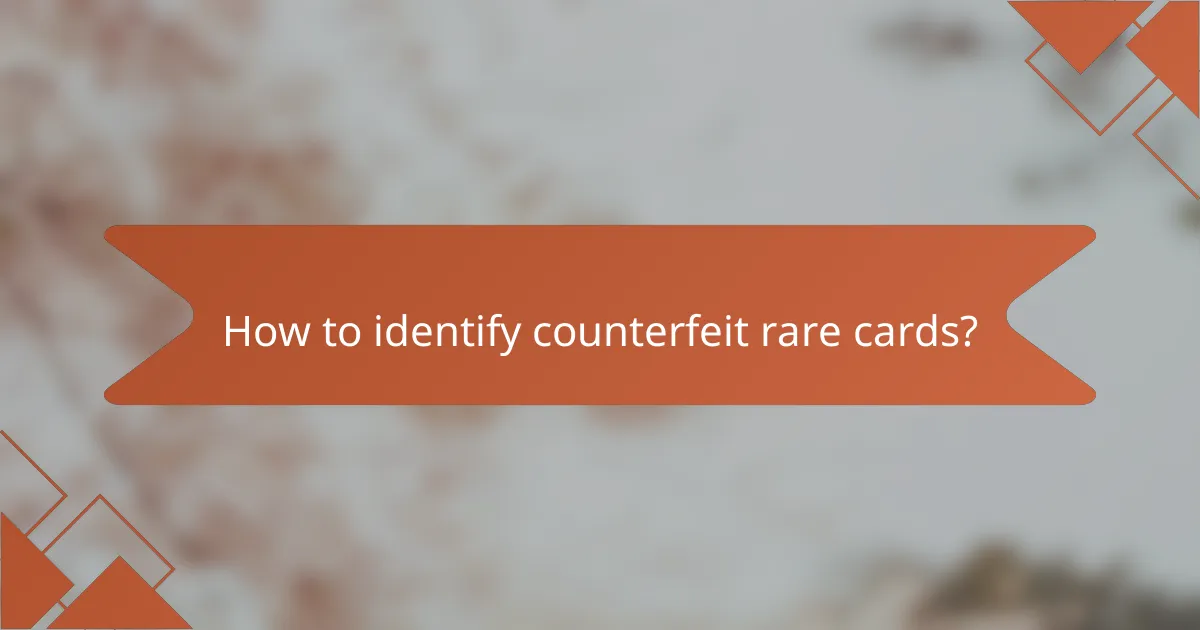
How to identify counterfeit rare cards?
Identifying counterfeit rare cards involves a combination of techniques and tools to verify authenticity. Key methods include using professional authentication services, conducting visual inspections, and comparing with verified examples.
Authentication services
Authentication services specialize in verifying the legitimacy of rare cards. These services often employ experts who use advanced technology and knowledge of industry standards to assess cards. Examples include PSA, BGS, and SGC, which provide grading and authentication for a fee, typically ranging from $10 to $50 per card, depending on the service and card value.
Choosing a reputable authentication service is crucial. Look for companies with a strong track record and positive reviews within the collector community. Ensure they offer a money-back guarantee for their assessments to mitigate risk.
Visual inspection techniques
Visual inspection techniques involve closely examining the card for signs of authenticity or forgery. Key aspects to inspect include the card’s printing quality, texture, and edges. Genuine cards typically have crisp printing and consistent color saturation, while counterfeits may show blurriness or uneven coloring.
Utilizing tools like magnifying glasses or UV light can enhance your inspection. For instance, UV light can reveal hidden security features that are often absent in counterfeit cards. Familiarizing yourself with the specific characteristics of the card series you are evaluating is essential.
Comparison with verified examples
Comparing a rare card with verified examples is an effective way to identify counterfeits. Collectors should have access to a database of authenticated cards or images from reputable sources. Look for discrepancies in details such as logos, text, and overall design.
When comparing, focus on specific attributes like the card’s serial number, holograms, and any unique identifiers. If possible, consult with fellow collectors or forums to gain insights on what to look for in authentic cards. This method can help you spot subtle differences that may indicate a counterfeit.
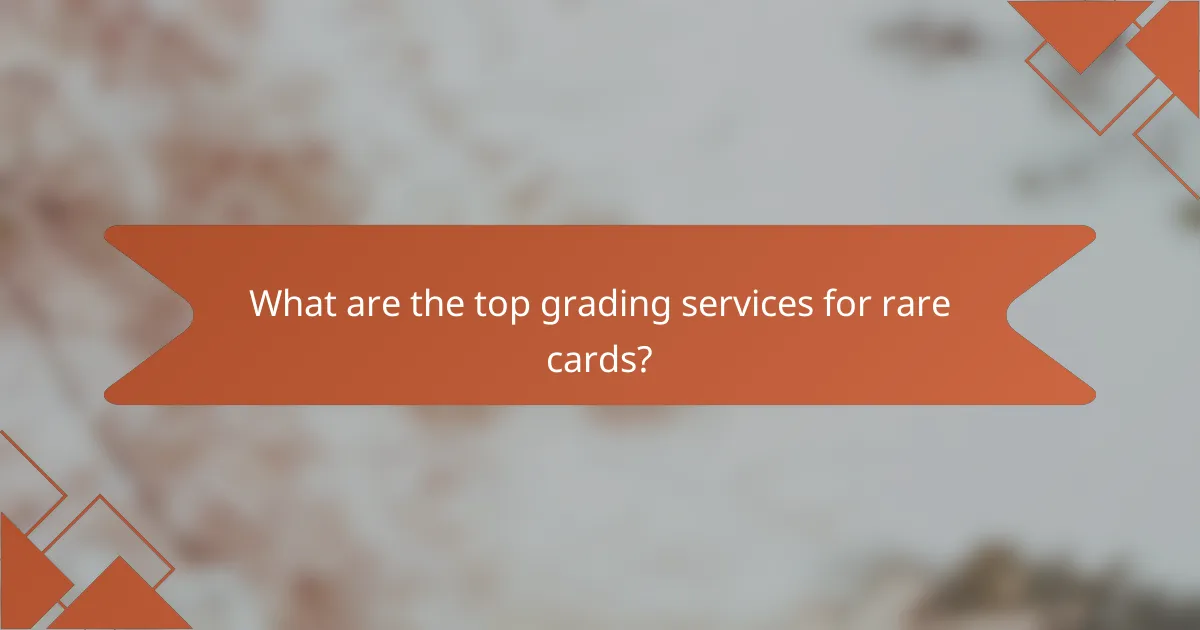
What are the top grading services for rare cards?
The top grading services for rare cards include PSA, Beckett Grading Services, and SGC. Each service has its own grading scale, reputation, and specific features that collectors should consider when assessing the value of their cards.
PSA (Professional Sports Authenticator)
PSA is one of the most recognized grading services in the world, known for its strict grading standards and extensive database. Cards graded by PSA often command higher prices in the market due to the service’s reputation and the trust it has built among collectors.
When submitting cards to PSA, collectors should ensure they are well-prepared, as the grading process can take several weeks. It’s advisable to check the current submission guidelines and fees on the PSA website, as they can vary based on card type and value.
Beckett Grading Services
Beckett Grading Services (BGS) is another leading grading company, known for its comprehensive grading system that includes sub-grades for centering, corners, edges, and surface. This detailed approach allows collectors to understand the specific strengths and weaknesses of their cards.
Collectors should consider that BGS grades can sometimes yield lower resale values compared to PSA, depending on the card type. It’s beneficial to compare recent sales of similar cards to gauge potential market value before submitting to Beckett.
SGC (Sportscard Guaranty)
SGC is well-regarded for its fast turnaround times and competitive pricing, making it a popular choice among collectors looking for efficient service. SGC’s grading scale is straightforward, and its holders are known for their durability and aesthetic appeal.
While SGC may not have the same level of recognition as PSA or Beckett, it has a loyal following, particularly among vintage card collectors. To maximize value, collectors should research recent sales of SGC-graded cards to understand their market positioning.
